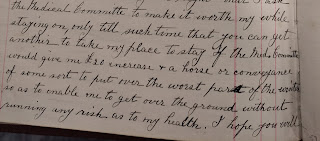“a horse or conveyance of some sort to put over the worst of the winter so as to enable me to get over the ground without running a risk to my health.”
This was a request made by Dr Jeannie Newton to the Medical Committee and Parish Council on the Orkney island of Papa Westray in October 1902, as a condition for staying longer in her post as Resident Medical Officer and Public Vaccinator. It indicates one of the challenges facing the doctors working on the island at the time and the problems which faced the island committees in appointing and retaining a resident doctor on the island.
 |
| CO6/11/1: Public Assistance Papa Westray Parochial Board/Parish Council Minute Book, 1895-1903, Orkney Library and Archive |
In December
1896, it was recorded that the Parish Council had received a “numerously signed
petition” from rate payers and others asking for a Resident Medical Officer to
be appointed for the island (population at the time 337). Until this time, Papa
Westray (or Papay as it is known
locally) was served by the Resident Medical Officer from the nearest island of
Westray. However, the distance between the two islands is 4 miles and bringing
a doctor across from Westray in the Winter was described as a “great risk and
expense”.
Despite the valiant efforts of the Parish Council and the Medical Committee to appoint and retain a Resident Medical Officer for Papa Westray, between 1896 and 1914 there were no fewer than 14 Resident Medical Officers for the island. In addition to the challenges of the local landscape and weather, especially in the winter months, there were frequent problems in finding accommodation for the doctor. Efforts to build a permanent residence were constantly thwarted by legal issues. Despite requests to the Local Government Board for Scotland for help, in particular additional financial support to pay a salary which would attract applicants, the Board do not appear to have been very supportive.
Interestingly, of the 14 Resident Medical Officers, 9 were women and there are several instances in the Parish Council minutes of the Clerk being instructed to advertise specifically for a “lady doctor”.
 |
| CO6/11/1: Public Assistance Papa Westray Parochial Board/Parish Council Minute Book, 1895-1903, Orkney Library and Archive |
Many of the women appear to have been young and recently qualified. We surmise that this would be because it would be less expensive to attract and appoint women and less experienced doctors. Most of these women stayed in post for less than a year. Perhaps they were daunted by the challenges of the environment. Or perhaps, like Dr Newton, they wanted to undertake further training. Others may have sought a wider experience of medicine than that offered by a small, isolated community.
The Parish Minutes from the time certainly give an interesting insight into the challenges faced by small communities to retain medical services. Similar issues were encountered in other smaller Orkney island communities and still resonate in the isles today.
Blog post written and researched by Jeanie Molyneux
The letter referred above was written to Mr Hourston, the Clerk to the Papa Westray Parish Council and presented to a joint meeting of the Parish Council and the Medical Committee at a meeting in October 1902. (CO6/11/1: Public Assistance Papa Westray Parochial Board/Parish Council Minute book, 1895-1903, Orkney Library and Archive)
Other References:
Taylor Rex (1981) ‘Doctors, paupers and landowners. The evolution
of primary medical care in Orkney’, Northern Scotland - First Series (1), pp
113-120.
Rendall Jocelyn. (1991) “Wanted a Doctor”, Orkney View
(30) October/November, pp28-30
Comments
Post a Comment